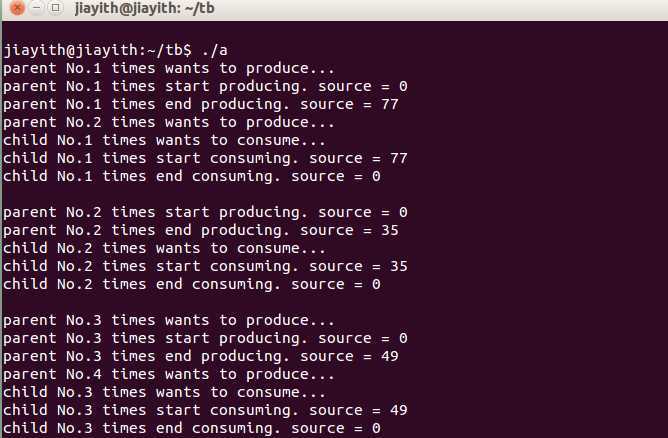标签:style blog http color os 2014
菜鸟偶遇信号量,擦出火花(只有不熟才会有火花)。于是上网搜资料和看《Unix环境高级编程》实现了几个小例题,高手请勿喷!这几位写得非常好啊:
题目来源: http://www.it165.net/os/html/201312/7039.html
信号量及其用法:http://www.cnblogs.com/hjslovewcl/archive/2011/03/03/2314341.html
Mutex与Semaphore区别著名的厕所理论:http://koti.mbnet.fi/niclasw/MutexSemaphore.html
哎呀,暴露了!我不是故意偷窥别人的……
一:一个生产者、一个消费者、一个资源情况
这种情况情况可以只用一个信号量,要生成或要消费只用尝试获取这个信号量,这里用了两个:full=1和empty=0,两个只为了和后面一致,1、0是赋初值。生产者和消费者情况如下:
//生产者: P(empty) 生成资源并放进资源处 V(full) //消费者: P(full) 消费资源 V(empty)
若生产者最先开始生产资源,P(empty),full和empty都成了0,此时若消费者想要消费,则P(full)时,full为0则睡眠等待,等生产者生结束就把full加1,看到消费者可怜地睡着了就唤醒它,然后消费者把full减1自己快活去了。
消费者消费过程中生产者若要生了,则会因为empty为0而休眠,等消费者结束就把empty加1,然后生产者开始生产。
上面的好理解,下面上代码:

#include <stdio.h> #include <stdlib.h> #include <unistd.h> #include <pthread.h> #include <x86_64-linux-gnu/sys/types.h> #include <x86_64-linux-gnu/sys/ipc.h> #include <x86_64-linux-gnu/sys/sem.h> int semInite(int semId, int value); int semDelete(int semId); int semP(int semId); int semV(int semId); //declare a union to be used union semun { int val; /* value for SETVAL */ struct semid_ds *buf; /* buffer for IPC_STAT, IPC_SET */ unsigned short int *array; /* array for GETALL, SETALL */ struct seminfo *__buf; /* buffer for IPC_INFO */ }; //semaphore declare static int semFullId; static int semEmptyId; static int source = 0; //source definition //new thread as a consumer void* child_thread(void* arg) { int ttt = 1; while(1) { sleep(rand() % 19); printf("child No.%d times wants to consume...\n", ttt); semP(semFullId); // printf("child No.%d times start consuming. source = %d\n", ttt, source); source = 0; printf("child No.%d times end consuming. source = %d\n\n", ttt++, source); semV(semEmptyId); // } return (void*)0; } int main(void) { //create semaphore semFullId = semget((key_t)1235, 1, 0666 | IPC_CREAT); semEmptyId = semget((key_t)1236, 1, 0666 | IPC_CREAT); semInite(semFullId, 0); semInite(semEmptyId, 1); pthread_t pid; pthread_create(&pid, NULL, child_thread, NULL); int tt = 1; while(1) { sleep(rand() % 18); printf("parent No.%d times wants to produce...\n", tt); semP(semEmptyId); // printf("parent No.%d times start producing. source = %d\n", tt, source); source = rand() % 100; printf("parent No.%d times end producing. source = %d\n", tt++, source); semV(semFullId); // } semDelete(semFullId); semDelete(semEmptyId); return 0; } //set semaphore as default value int semInite(int semId, int value) { union semun semUnion; semUnion.val = value; //set default semaphore return semctl(semId, 0, SETVAL, semUnion); } //delete semaphore int semDelete(int semId) { union semun semUnion; return semctl(semId, 0, IPC_RMID, semUnion); } //semaphore P operation int semP(int semId) { struct sembuf semBuf; semBuf.sem_num = 0; //indicate it is not semaphore array semBuf.sem_op = -1; //subtract one semBuf.sem_flg = SEM_UNDO; return semop(semId, &semBuf, 1); //return value } //semaphore V operation int semV(int semId) { struct sembuf semBuf; semBuf.sem_num = 0; //indicate it is not semaphore array semBuf.sem_op = 1; //subtract one semBuf.sem_flg = SEM_UNDO; return semop(semId, &semBuf, 1); //return value }
两个线程,创建的新线程当做消费者了。其中unix的几个信号量的函数看了半天,有点复杂,简单不准确来讲:
//获得一个信号量啦,第二个参数是想要创建的信号量个数, //因为unix操作的是信号量集合,设为1不就一个信号量了嘛 //其他参数我不管了 int semget(key_t key, int num_sems, int sem_flags); //信号量集合的操作,这个可以用来实现P、V的 +1 -1 的功能 int semop(int sem_id, struct sembuf *sem_ops, size_t num_sem_ops); //信号量集合的控制,如初始化删除等 int semctl(int sem_id, int sem_num, int command, ...);
运行:

Linux 信号量 生产者消费者小例题 (嘘,我是菜鸟~),布布扣,bubuko.com
标签:style blog http color os 2014
原文地址:http://www.cnblogs.com/jiayith/p/3854312.html